Carbon Air Aims to Make Air Suspension More Like Coil - Pond Beaver 2021
When a press release entered my inbox for a product made from coconut shells and sawdust, which slots into your air spring but somehow has the effect of increasing its volume, I assumed it was a late April Fool's submission. But Carbon Air is the real deal. They've been making products for the air suspension in Audi's A6 and A7 cars since 2017. Now, they're developing their product for mountain bikes.
What is it?
First off it's worth refreshing how conventional volume spacers work and their limitations. Adding spacers increases progressiveness, making it harder to bottom-out for a given amount of sag. But in some applications, it can be hard to use all the travel even with all the volume spacers removed. This is particularly true of long-travel single-crown forks, because the longer the travel, the closer the piston gets towards the top-cap at bottom-out, so the higher the compression ratio. Air spring upgrades which increase the size of the negative chamber - such as RockShox's MegNeg or Vorsprung's Luftkappe, make it harder still to bottom-out because they soften the beginning-stroke far more than the end-stroke, and require more pressure to achieve the same sag.
Put simply, Carbon Air's product does the opposite of a volume spacer. It's made of activated carbon, which is produced by exposing carbon-rich material like sawdust, coconut husks or coal to steam and chemicals, and is used in many industrial applications like hydrogen gas storage (hydrogen likes to leak out of steel tanks) and air filtration. You can think of it like a super-fine foam, with lots of tiny pores within pores in a fractal structure, giving it a surface area of well over a thousand square meters per gram. (For American readers, that's about twenty football fields per quarter-pound).
This enormous surface area allows it to adsorb (yes, adsorb with a "d") more gas molecules than would normally occupy that volume at a given pressure, because they "stick" (adsorb) to the material's surface through something called van der Waals forces. And the higher the pressure, the more air the material adsorbs. According to Carbon Air, this allows one cubic centimeter of their material to take up as much air as two cubic centimeters of empty space. So, counter-intuitively, the more volume of an air spring you fill with activated carbon, the bigger apparent volume it has.
What does it do?
So Carbon Air can make air suspension less progressive. This could be useful for those who struggle to use all the travel while maintaining appropriate sag. We could stop there, but there's much more to it than that.
While air springs are progressive in the last part of the travel (and this is a good thing, within limits), they are digressive in the first part of the travel. In other words, they have a stiffer spring rate (that's the change in spring force per unit travel) at the start of the travel than the middle. In fact, air springs are often more than three times stiffer off the top than in the middle (older air springs could be over ten times stiffer). It's as if you had a coil spring suited to a 150Kg rider at the start of the travel, then swapped to a spring for a 50Kg rider once you got to the middle. This is what causes air suspension to lack suppleness and traction at the beginning of the travel, while also lacking mid-stroke support.
One solution is to increase the volume of the negative air chamber, which reduces the initial spring rate relative to the mid-travel. But larger negative chambers make it harder to use full travel for a given sag. To ensure most riders can use all the travel with a reasonable amount of sag, mainstream manufacturers want to keep the ratio of positive to negative volume constant. In an ideal world, the positive and negative chambers would be so large the spring curve would be basically linear (but could still be made progressive with volume spacers if desired). The main problem is space. In a single-crown, long-travel fork there basically isn't enough room to do this. The same goes for an air shock which must fit into multiple frames and around water bottles. Apparently, space is a primary constraint in car suspension too, which is why Audi worked with Carbon Air.
This is where activated carbon could be very useful. Whether used in the positive chamber to reduce the bottom-out force when combined with a large negative chamber (e.g. MegNeg or Luftkappe), or in both chambers of a regular air spring.
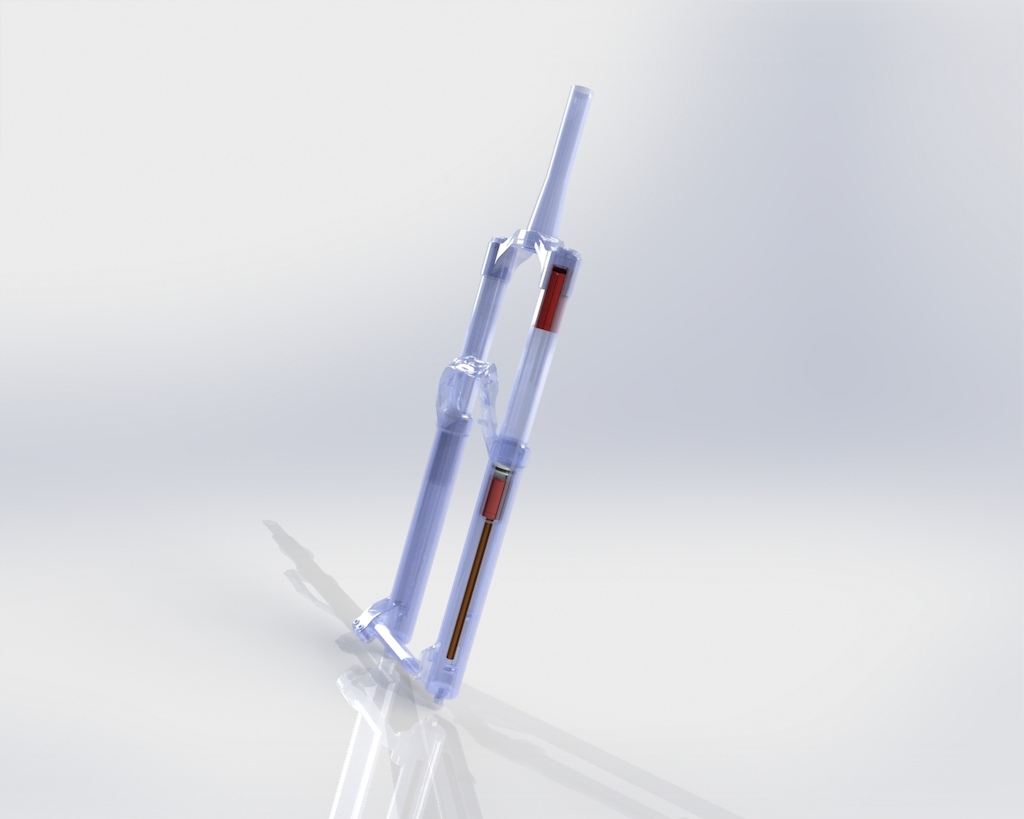
Activated carbon could be used in both positive and negative chambers to give a more coil-like spring curve.
There's one more potential advantage to Carbon Air's product, but to explain that we'll have to cover a little physics. In an air spring, the stiffness depends on speed. This is because when a gas is compressed it generates heat, and when it expands it takes in heat - this is why your hand pump gets hot when compressing air and your CO2 canister gets cold as the gas expands. This heat generated during compression causes an additional increase in pressure over and above what you'd expect if the gas was at a constant temperature. This causes an increase in the force required to compress the gas quickly (adiabatically) compared to slowly (isothermally), where the heat has time to escape.
This heat dissipates very quickly (with a half-life of about 0.1s, according to Steve Mathews of Vorsprung suspension), so it's most significant in very fast suspension movements. But essentially, air springs are softer in slow compression like cornering and braking, when compared to very high-speed compression like a hard landing. Whether that's a bad thing is debatable, as it can be offset with reduced high-speed damping, but this is another reason why air suspension can lack support under slow movements like braking and cornering, but can be reluctant to use all of its travel on a big impact.
According to Carbon Air, their product absorbs the heat generated during compression and releases it during rebound, keeping the temperature of the gas very consistent. The high surface area and high thermal mass (compared to the gram or so of air in an air spring) of the activated carbon makes it a great heat sink. So, according to its manufacturers, it virtually eliminates the speed-sensitivity of air springs, making them perform even more like a coil while still preserving the lightness and tune-ability of air.
Tobias Ackroyd, Product Development Engineer Carbon Air, also mentioned the possibility of using their product in conjunction with a volume spacer if you wanted to maintain the same progressiveness but still offer the benefit of reduced speed-sensitivity.
I did wonder if the material takes time to adsorb air during compression, which could introduce another speed-sensitive effect as the insert would act like a volume spacer until the air had time to "soak in" to the material. I asked John Coakley, CTO of Carbon Air, "Can it adsorb air fast enough to keep up with the fastest suspension movements, which are somewhere in the region of 10Hz [ten cycles per second]?" Apparently, activated carbon can store and release air so fast it's effectively instantaneous as far as suspension is concerned: "It's used in loudspeakers where you can see adsorption and desorbtion [the reverse of adsorbtion] in these materials up to 400Hz," John told me, "so for this application, you're not going to see any speed-sensitive effects."
The future
Carbon Air is discussing with suspension manufacturers the possibility of integrating their product into future air spring designs. For obvious reasons, they were not keen to share any more details on that. As for whether it will be available aftermarket to effectively increase the positive and/or negative volume of existing air springs, that may depend on the result of those discussions.
Personally, I'm a a big fan of negative volume upgrades like the RockShox MegNeg and Vorsprung Luftkappe, but in some applications (frames with progressive leverage curves and long travel forks, respectively) they can make the spring too progressive. An aftermarket option which makes it possible to make use of these upgrades without excessive end-stroke force could be a step forward for air suspension.
Author Info:
Must Read This Week
Sign Up for the Pinkbike Newsletter - All the Biggest, Most Interesting Stories in your Inbox
PB Newsletter Signup
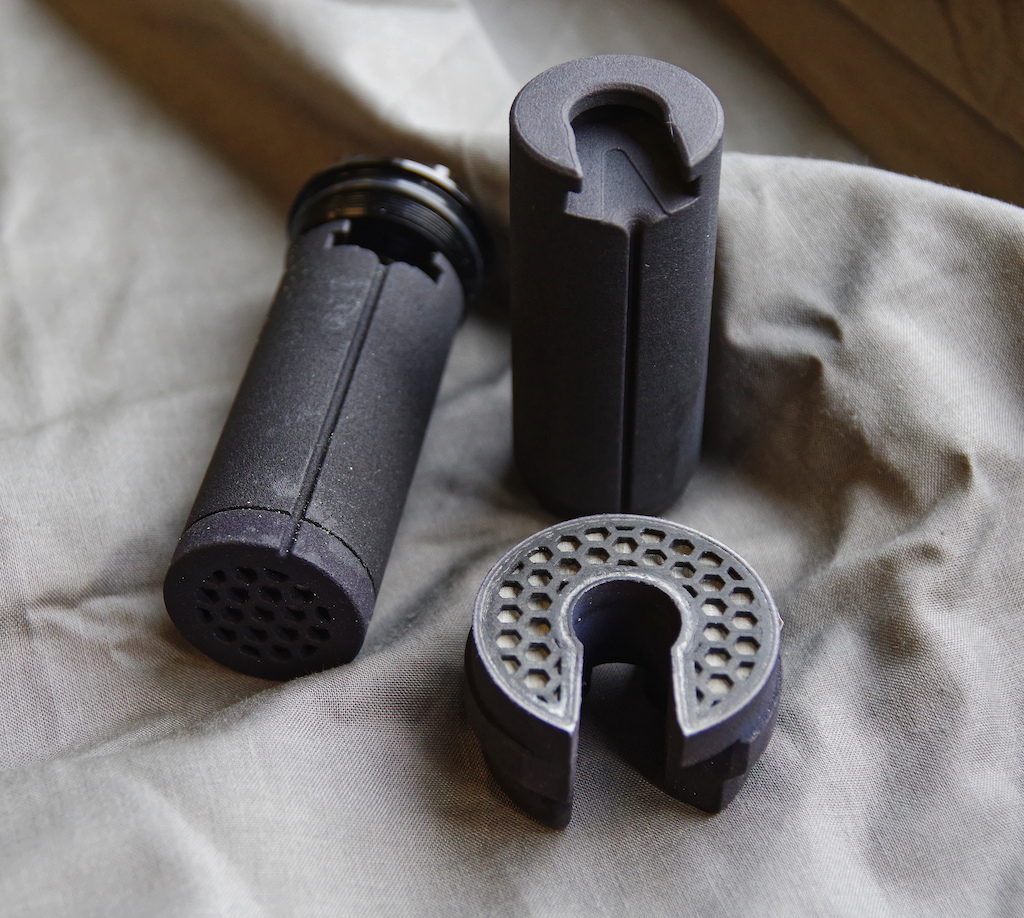

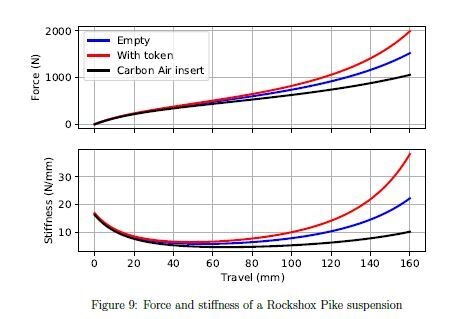

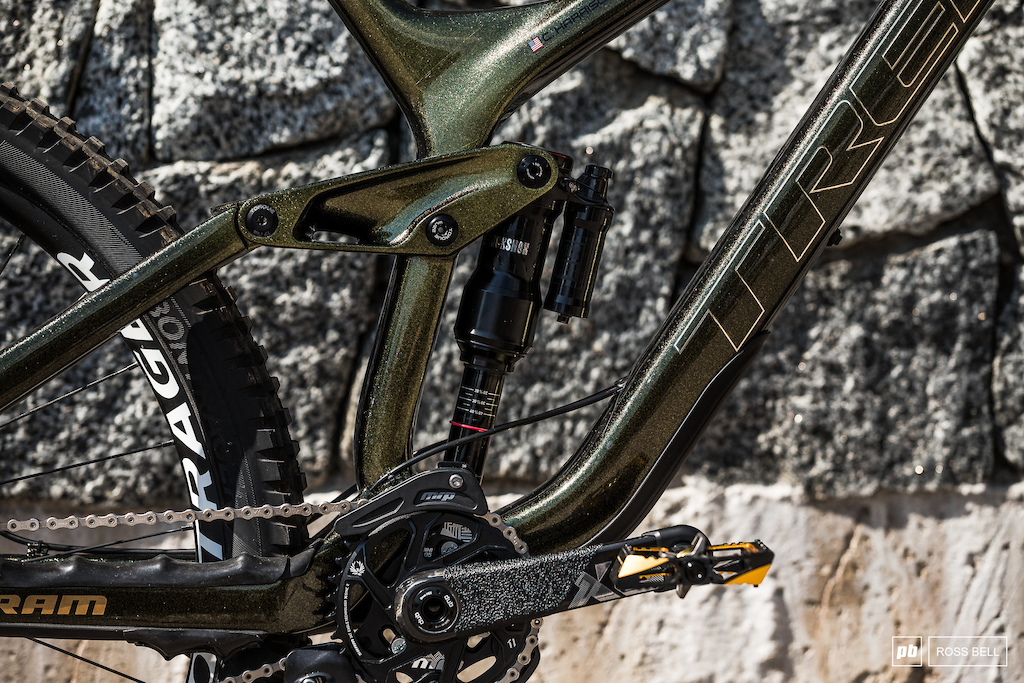
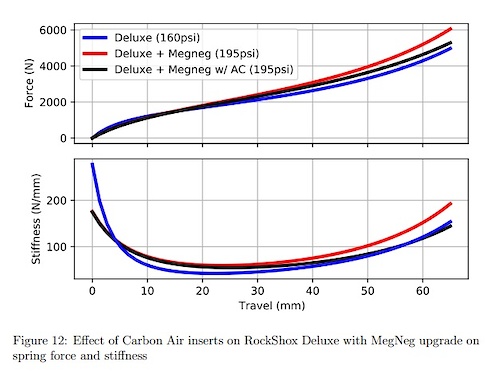


www.pinkbike.com/news/review-formulas-neopos-volume-spacer.html
progressiveness is what happens when the fork goes through it's travel. Lets say you have an un-squished fork with 80 psi in it, this is going to feel pretty soft in the initial part of the travel when you press down on the bars. Now let's say you land a jump and your fork sinks all the way to the end of it's travel. You still have the same amount of air in your fork, but now your fork is shorter, and the air has less space to be in. the same amount of stuff in a smaller space results in an increase in pressure, there's now maybe 150psi in your fork. These aren't exact numbers but I'm sure you get the idea.
Just picture it like trying to pop a gym ball by hugging it, it's easy to press it to start with, but the harder you squeeze it the higher the air pressure inside it gets and therefore harder to squeeze it further.
This article is about a material that can absorb more air than just a straight air chamber. I think this means that the air spring will feel like it's bigger and softer than it actually is, resulting in a softer ride.
I hope this helps
NEO POS, are soft and squish and so the more ramp and pressure applied, the more the squish to allow for a slower decrease in volume. Yes, different from what these carbon spacers do.
I started reading the article sceptically, then relaxed when it became apparent Seb knew what he was talking about so well he could explain it without a reliance on hand waving and jargon.
I genuinely never expected an (accurate) straightforward disambiguation for adiabatic and isothermic on Pinkbike. Top stuff @seb-stott and PB for bringing him onboard.
Hahah. Literally have to reference everything to football fields. Or BigMacs.
It's a lost cause. If only we could just be metric like the REST OF THE WORLD....
www.pinkbike.com/photo/20421092
These are going to live inside a lightly oiled environment- tokens are always oily when removing them after use.
If this improves the beginning of the air stroke and coils get hydraulic bottom out, then maybe all forks will have close to ideal progression.
Then the coil/air debate will mainly about weight and sensitivity.
My current air is set in my house at 74 deg F (23.3C) but current outside temps are 90 F (32.2C) but soon to be in the 100's. If I ride in the morning it will be 60 F and all of those temps will definitely change the feel. Ugh then going up north this summer to escape the heat where I'll gain 5-6000 (1828m) feet will also affect the PSI.
The A7 Audi for example has fully automated ride height and damper control.
And Porsche, well let’s just remind ourselves of the Oxides of nitrogen debacle that saw the head of Porsche engines quit after getting caught.
Blindly believing slick marketing talk is what has filled the bicycle industry with overpriced rubbish.
Also, LH OHV is rad, ya' hater
Totally get your point though. Why go through such great lengths to get a coil like feel when a coil exist.
An airspring will always allow for fine tuning that just isnt possible with coil.
I like the idea of the coil conversion but I don't understand why would someone want to make coil work more like air... when most to make air feel like coil... I respect Vosrprung but... this is a bit confusing. In the old days coil fork was 300-350g heavier than it's air version (like first gen Lyrik), and if you found a titanium spring, it would go down to 200-250g difference.
Push ACS-3 added 275g to my Fox 36. and 250g to a Pike.
I saw posted weights/photos where a Vorsprung smash added abuot 400g. Other posts backed up that Smash adds a little more weight, I think because their spring is longer to make it compatible between brands. Anyway just wanted to post some real world weights for anyone considering the conversion. Besides the improved feel, I was surprised how much I enjoyed the "never have to check or fill your fork again or worry about temp or altitude.". It seems like my pressure would always be prretty good until I didn't check it for a few rides and hten all of a sudden 30 minutes from the car would realize it had lost some pressure. But I still wouudln't have made the switch but for the improved feel.
To give a standard of comparison, a 29" Lyrik or 36 with Smashpot is around 2400-2500g for most spring rates. A 66RC2X was 3160g (www.bikeradar.com/reviews/components/forks/suspension-forks/marzocchi-66-rc2x-review) in 26".
With the smashpot I have no air chamber and can do the same thing with just a hydraulic knob on the power like the rebound knob only for buttom out control. And off 180mm of travel.
Yea I understand too; they hate bikes.
I’d always imagined that the air was trying to squeeze through past the seals. But I guess you can use the difference in air pressure between each side of the seal to your advantage. Neat. Thanks for the insight
It can’t be that hard to make a 900 psi shock pump, can it? Shocks and forks usually come with a shock pump anyways so why not ship a 900 psi shock pump and use this design?
Maybe it simply does, but . . .I'm skeptical
I have a Luftkappe in a 150mm Pike that could go to 160mm except at that point it’s too progressive (with zero spacers) to ever get full travel.
Start packing your air cavities!
My wife also appreciates it when take charcoal to adsorb the gas.
I was waiting to pounce re the adsorb vs absorb.
Computer modern typeface on that figure, got a link to that document? Looks legit.
Also: probably the first product launch I've ever seen that shows graphs with actual units, and it's hated... This is why we can't have nice things.
This can also be done with longer stanchions of course - I've tried running my Lyrik at 140mm and prefer it to Pike at 140mm - I guessed because the travel stays in better behaved area of air spring.
Over to Seb, what's in your WRC car.
www.wrc.com/en/news/news-archive/wrc/ogier-restart-in-doubt
www.wrc.com/images/redaktion/Season-2020-NEWS/WRC/6_June/020620_Five-biggest-tech-breakthroughs-05_dff57_frz_1400x788.jpg
If this was that good then WRC would be all over it.
Sticking with my old school coil spring thanks.
Its 200g heavier, makes my bike 1% stiffer, is 2% less adjustable on the spring rate, but 5% better on the trail. Never suffers from air leaks, ambient temperature shifts or sticky seals.
I run a RUNT, and it allows u to use a lower then normal main chamber air pressure for a supple beginning stroke. And the second chambers high pressure side, creates a magic supportive mid stroke platform to ride off. Interesting tech, good article!
Seeing as Fox advise a 'splash' of Fox Gold in my forks air chamber:
What happens as that surface area becomes contaminated with lubricating fork oils? Will the adsorption rates diminish and change dramatically, in effect just turning into a regular old 'token'
Will it need to be decontaminated regularly for maximal operation.
[Reply]
carbonair.co.uk/2021/03/29/carbon-air-products-in-bike-air-suspensions-and-shocks
www.deaneasy.it/en/shop-deaneasy/abs-fork-tune-comfort-and-grip
I think I've seen other versions as well.
I'm interested in trying it, but I'm a kook.
From Formula Neopos (basically the same as deaneasy):
"Neopos makes it possible to make the air fork’s progression curve more linear..."
From above:
"So Carbon Air can make air suspension less progressive..."
and for good measure, "You can think of it like a super-fine foam"
Neopos/Deaneasy acheives this through an easy to imagine a change in density:
air-to-spacer volume ratio in the chamber changes as the foam is compressed the stroke,
like when you squeeze a foam stress ball.
Carbon Air claims that van der Waals forces allow their material
to "adsorb" more air as the pressure increases,
such that "the more volume of an air spring you fill with
activated carbon, the bigger apparent volume it has."
So, essentially, there is x amount of air in chamber at start of stroke,
and as the Carbon Air is compressed, additional air volume is 'created'
during collection of air molecules in a film on the surface of the material.
But, of course, this air chamber is sealed by necessity.
So if air was actually being "created", it would be be pulling from outside the sealed chamber,
which would be bad.
So, I think it might be accurate to say the Carbon Air material is *also* increasing in density,
but instead of expelling air like a foam, it is collecting ("adsorbing") air,
using it to make the CarbonAir material, by way of SCIENCE, more dense.
If my interpretation of CarbonAir's performance is correct, (a big if, I know)
both products would be trying to regulate compression of the air by adding a variable density
material to the chamber, or to put it another way, by displacing air during the course of the stroke.
If the CarbonAir compression process does actually reduce heat,
that would mean the Neopos process would increase heat,
so maybe that is a clear benefit.
----> www.rideformula.com/technologies/neopos
note that on this chart the gray line indicates a standard rigid token and "standard" is the fork without volume spacers. Both the standard and neopos are both more progressive that the standard system with no form of token in it. Now take a look at the spring curve chart labeled figure 9 in the article above. The carbon air insert is less progressive than even the standard set up with no tokens. So it is effectively the complete opposite of a token, it is a volume sink or essentially a "negative token".
Many are probably thinking why would I want to do this when tokens are so popular and work so well for many people? While that is the case for some riders there are those at the other end of the spectrum like lightweight riders who have trouble getting full travel while maintaining mid body support who could really benefit from this. This is just one application of the material though. Putting it in the negative chamber is a totally different story.
I think your description as the "volume sink" is a very apt one, and
better illustrates the concept than the rather esoteric "adsorbtion".
What I imagine happening, based on the chart,
is that as the piston compresses, the CarbonAir is whisking the air into its nether-regions,
so that the pressure comes up more slowly.
Or, as you said in your initial response, "the opposite of a volume spacer."
I also think you're correct in your assertion that
"many are probably thinking why would I want to do this?"
Mr Stott does say, in describing the limitations of conventional spacers, that they "[increase] progressiveness, making it harder to bottom-out for a given amount of sag."
But I think he (CarbonAir?) could probably be clearer about the intended user for this product,
or I could stand to be more obsessive about setting up my sag,
and therefore immediately identify the problem this solves.
From what you're saying, it's simply the equivalent tool for lighter riders,
that conventional volume spacers are for heavier riders (or those with a "heavier" riding style)
In the same way larger riders would typically have to jack up the pressure to get support,
lighter riders sometimes have to take a bunch out to get any movement from the suspension.
Each type of spacer allows the rider to keep the pressure of the fork at its optimum range,
while accomodating their unique weight or riding style.
Like I said, I think it's all in there, but maybe overshadowed by jargon.
Cheers!
P.S. with a title claiming to "make air suspension more like coil"
I would have expected to have a coil shock spring rate somewhere on the charts.
It might help for them to have an animated chart,
showing of how their curve compares to a coil spring,
and how adjusting the air pressure basically equates to an infinitely adjustable coil spring
(vs the small assortment for actual coil springs)
Just my humble opinion, but I think their pitch needs work, maybe they should hire you
Let’s get the best of both worlds.
A coil spring!
As the late DMX would say "Carbon Air gon' give it to ya"
They can make products that don't work for all products in the line or all people. For example coil conversions for forks are insanely heavy and will likely never be specced OEM. But a few people who understand the tradeoffs would purchase these from a boutique manufacturer.
Vorsprung makes the Secus that doesn't work at all for longer single crown forks like the 38 and zeb in longer travel configurations. This makes it hard for OEMs to sell a product that isn't compatible with their whole product line or even to put in the R+D for just a few models.
There are a few more great points I can't remember but I jut love to see people trying new things and specifically not trying to cater to everybody like the OEMs are forced to do.